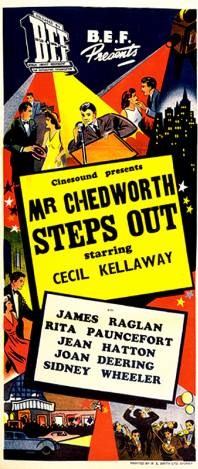Development
The script was based on the English novel, Mr Chedworth Hits Out (1936) by F Morton Howard. [8] Filmink noted "It wasn’t a well-known book, and Howard wasn’t that famous an author, and thus the title had little pre-sold-IP factor. However, the novel did offer a splendid role for Kellaway." [3] The script was adapted by Cinesound's regular writer Frank Harvey; it has been called "a patchwork quilt... full of contrivances and repetition." [3]
The movie was intended as the first of a projected £200,000 five-film program by Cinesound Productions, the others being Gone to the Dogs (1939), Robbery Under Arms, The Further Adventures of Dad and Dave (which became Dad Rudd, MP 1940), and The Haunted House. [9] Robbery Under Arms and The Haunted House were never made.
The film was specifically designed as a vehicle for Cecil Kellaway. He had been working in Hollywood following the success of It Isn't Done (1937) but agreed to come back to Australia especially to make the film at the request of Ken G. Hall. "He was getting much more money than we had offered him but he felt that he owed us something", said Hall. [10] [11]
Kellaway was under contract to RKO so Cinesound had to get their permission to borrow him for the film. It was thought this was the first time the Hollywood studios had done that for one of their actors to appear in an Australian film. He was borrowed for four months. [12]
Kellaway later said he was attracted to the lead role:
It is the part of a human being, not a screen stereotype, for 'Mr. Chedworth' is fighting a battle of circumstances. A lonely, down-trodden little man, he is fighting to uphold his inner better self. It will carry a message to every home, because it depicts the strange fact that it is in our homes we find our harshest critics. There is drama and comedy delightfully combined, when George Chedworth, reclaiming himself as a man, becomes at last the head of his house, and . . . steps out! [13]
Support roles
The part of Cecil Kellaway's youngest daughter was played by Jean Hatton, a young singer who was brought to the attention of Ken G. Hall after she won a Deanna Durbin talent quest. She was signed by Cinesound to a long-term contract, later appearing in Come Up Smiling . [14] Her part in the film was written especially for her. [15] She sings two songs during the film's climax, "If It Rains, Who Cares" and "Lo, Hear the Gentle Lark", which was staged in a massive 40-foot set build for the film replicating a radio station. [13]
Rita Pauncefort, who plays Kellaway's nagging wife, was a highly experienced actor of stage and film. [16] She had first acted opposite Cecil Kellaway in South Africa in 1914. [17]
Joan Deering, who plays the ingenue, had never acted on screen before but had a strong theatrical background, having toured with revue companies in England and South Africa. She was English and moved to Australia in 1935 after touring with Frank Neil's pantomime company. Ken G. Hall had met her socially and suggested she screen test. [18] Peter Finch was cast after the impression he made in Dad and Dave Come to Town (1938). [19]
Shooting
Kellaway arrived back in Australia in early October 1938 [20] and shooting took place through that month to November. [21]
Most of the film was shot in Cinesound's studios at Bondi with some location work at Lapstone Hill [22] and Sydney Girls High School. [23] A farewell ball to celebrate the end of shooting was held in December. [24]
There is a line in the film where Cecil Kellaway scolds his son (Peter Finch) for betting on horses. During filming this caused the crew to burst out laughing because Kellaway was known as a keen gambler. "He had his mind on the racetrack all the time", said Hall. "As soon as I'd say 'Cut!' he'd be off like a rabbit up a bank and out the back to the radio to hear what had won the last. He was a mad punter." [25]
Costumes were designed by Thelma Afford, wife of top Australian writer Max Afford. [26]
Hall was paid £30 a week to direct while Frank Harvey was paid £20 a week over four weeks to write it. Kellaway's fee was £500, covering eight weeks. [2]
